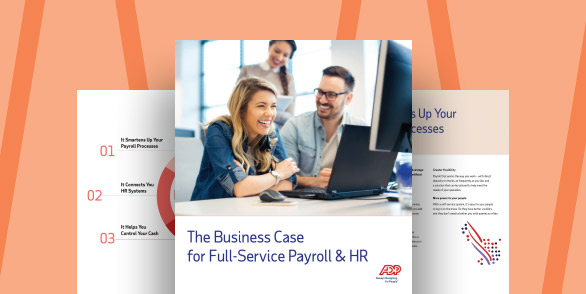Unexpected events and times of rapid change can negatively impact business growth and productivity. The challenge for many organizations in these situations is that the people best equipped to alleviate disruptions are also responsible for paying employees accurately and on time. As resources become stretched too thin, employers may have to consider moving away from in-house payroll and outsourcing the responsibility to a third-party provider. Doing so can help them and their HR teams respond to the inevitable ups and downs of the market and turn problems into opportunities.
Table of Contents
What is in-house payroll?
In-house payroll means paying employees and managing all the tasks that come with it – filing payroll taxes, keeping payroll records, maintaining compliance, etc. – without assistance from outside the organization. Depending on business size, this approach to payroll may require hiring employees, creating an HR department and purchasing payroll software.
How does in-house payroll work?
With in-house payroll, the employer, a dedicated payroll administrator or a team of payroll practitioners perform the following:
- Track employee hours and calculate gross pay
- Process all statutory and voluntary deductions
- Pay employees according to state pay regulations
- File tax reports with federal, state and local agencies
- Store payroll records for the requisite lengths of time
Pros and cons of in-house payroll
Benefits of in-house payroll
The traditional case for in-house payroll is that it gives employers more control over timing, processes, and costs than outsourcing. However, this argument is not always valid due to advancements in payroll service models and technology. Employers today can often choose their level of involvement – whether they want to be hands-off or prefer to stay involved in their companies’ payroll operations.
Drawbacks of in-house payroll
HR, payroll and compliance are not areas of expertise for most organizations. Many also do not have the bandwidth to spend valuable hours on time-consuming payroll tasks. Consequently, employers often find that partnering with a third-party vendor whose core business is HR and payroll lifts a huge burden off their shoulders and allows them to focus on more strategic and impactful initiatives.
In-house payroll vs. outsourcing
Is outsourcing payroll a good idea? It can be in many circumstances.
| In-house payroll | Outsourced payroll | |
| Processes | HR practitioners may have to intervene manually, creating inefficiencies that get in the way of business growth. | Team members are freed from manual tasks so they can concentrate on more strategic projects. |
| Integrations | Custom work may be required to integrate payroll with time management and other HR processes. | Payroll easily integrates with HR solutions, including those from third parties. New capabilities and tools can be added as the business grows or needs change. |
| Compliance | Complying with payroll-related regulations can be time-consuming and costly. | Assistance with compliance updates reduces the payroll team’s workload. |
| Analytics | Workforce data may be outdated or difficult to access when it’s needed most. | Employers have a single source of accurate, shareable data so they can strategize and make decisions easier. |
| Expertise | Payroll practitioners might be overworked, stressed or lack necessary skills. | An experienced partner provides expert, dedicated support for payroll, compliance and more. |
| Experience | The digital, mobile or employee portal experience may be poor. | Online direct-access and mobile options provide employees with flexible payment methods and easy access to their pay information. |
| Cost | Multiple service contracts can make cost management challenging. | A single contract provides complete transparency of payroll costs. |
Transitioning from in-house payroll to payroll outsourcing
The first phase of a smooth transition is assessment. Employers need to document the specific payroll problems and inefficient processes they’re experiencing and consider how a managed payroll service provider can help address them. Some common issues for companies managing payroll in-house include payments behind schedule, data security and payroll practitioners struggling to keep pace with inquiries.
After the initial evaluation, employers must define what they want their payroll function to look like in five years. This step can help them better understand long-term costs, reduce the risk of non-compliance and set up an easy-to-use reporting structure.
How to choose an outsourcing provider
Payroll outsourcing services, including the hands-on support and technology available, vary by provider. The following steps may help employers source a partner that fits their needs:
- Be clear about objectives
Supply potential partners with as much accurate information as possible about the work being outsourced and the level of service expected.
- Examine the vendor’s track record
Verify that the payroll company is financially stable and has experience working with similar organizations in the region.
- Consider the cultural fit
Discuss the organization’s culture and brand with the provider.
- Agree on cost
Ensure that payment is tied to the achievement of clearly defined performance targets.
- Build in flexibility
Set dates to review the partnership so it can be adjusted to accommodate changes in the organization or broader business environment.
Frequently asked questions about bringing payroll in-house
What does "in-house payroll" mean?
In-house payroll means that a business manages the entire payroll process using only its own resources, including labor and technology. The alternative is to contract a payroll service provider to handle some or all of the payroll responsibilities on the employer’s behalf.
How to process payroll in-house?
To do in-house payroll processing, employers usually need to purchase technology and either hire a payroll administrator or staff an entire HR department. This approach can be expensive and inefficient depending on the business’s size and payroll needs. For instance, hiring payroll practitioners has overhead costs, e.g., salary and benefits, and custom-built technology may not easily scale with business growth.
Can I do payroll manually?
Some small businesses opt to process payroll manually in-house because they think it will help save money. However, this approach often leads to the following difficulties:
- Time burden of handling daily administrative tasks
- Overloading employees with payroll and HR tasks outside their intended role
- Risk of costly payroll, compliance or tax errors without expert support
When companies do payroll in-house, what is the payroll module typically part of?
Businesses that manage payroll in-house typically purchase technology for that purpose. Compared to outsourcing, purchasing and maintaining a payroll solution may not be the most effective option. Potential drawbacks include:
- Variable purchase and set-up costs
- Limited technology support
- Minimal resources for making HR more strategic
- Internal employees must dedicate time to learning and running the technology
What is the difference between in-house payroll and outsourcing?
In-house payroll differs from payroll outsourcing in three primary ways – optimization, visibility and agility.
- Optimization
Moving away from legacy, in-house payroll systems can help employers radically optimize processes and efficiently respond to planned and unplanned business disruptions and opportunities.
- Visibility
Running multiple in-house systems with limited integration gives employers a disjointed view of their payroll. In contrast, payroll outsourcing enables payroll data to be easily shared, supporting collaboration and more informed decision-making.
- Agility
In-house payroll teams often struggle when their employers expand into new markets, recruit staff in different countries or undergo mergers and acquisitions. These issues are more manageable with outsourcing due to unified payroll platforms that can analyze data quickly and scale with business growth.
This article is intended to be used as a starting point in analyzing the in-house payroll meaning and is not a comprehensive resource of requirements. It offers practical information concerning the subject matter and is provided with the understanding that ADP is not rendering legal or tax advice or other professional services.





